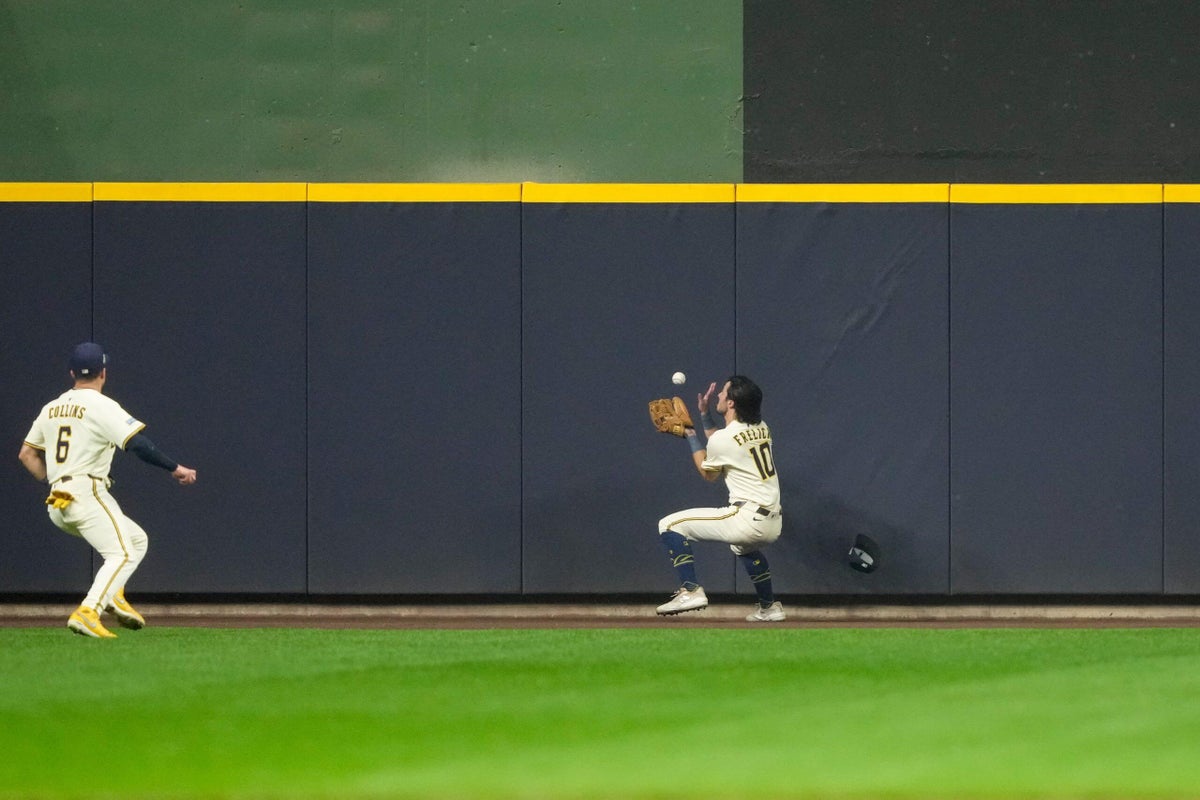MILWAUKEE — What will you tell your grandchildren about the strangest double play in postseason history? Whatever it is, they might start looking at you funny.
How will you make them understand that Max Muncy pulverized a baseball 404 feet, and it turned into a “ground-ball” double play?
How will you explain that it was a “ground-ball” double play with no actual “ground” in it?
How will you try to put into words that this was a baseball that came within inches of clearing the center-field fence, for what would have been a grand slam … and somehow, when the dust settled, there were no runs at all on the board and the catcher wound up recording two outs — at home and then at third?
This really happened Monday night, in the fourth inning of Game 1 of the National League Championship Series. And the funny thing was, in pretty much every other way, this game was a certifiable October classic:
Dodgers 2, Brewers 1. … Dodgers starter Blake Snell spent eight innings carving an all-time postseason, 10-strikeout, one-hit, no-run masterpiece. … The Brewers would leave the bases loaded in an ear-splitting bottom of the ninth. … And from start to finish, it all left hearts pounding.
Yeah, that was special, all right … but how ’bout that wacko double play!
This is the column where we’re going to tell you all about that double play. We have been commanded by baseball fans around the world to do just that. And we aim to please.
How bizarre was it? Ha. Here it comes, everything you ever wanted to know about how weird it truly was, but forgot to ask.
Could it really have been that strange?
Let’s start this way. First, we’ll present the official play-by-play description Major League Baseball furnished us on this play. Then we’ll show it to you once again. And please tell us whether that description and that video are somehow the same play.
Here’s the description — Max Muncy grounds into a double play, center fielder Sal Frelick to shortstop Joey Ortiz to catcher William Contreras. Teoscar Hernández out at home. Will Smith out at third.
Now here’s what it actually looked like:
WHAT JUST HAPPENED?!?!?! #NLCS pic.twitter.com/x7BbmJ6hzX
— MLB (@MLB) October 14, 2025
What the heck!
There’s a word for all those Dodgers running the bases: Confused!
The runner on third, Teoscar Hernández, who forgot to tag up, could have sprinted home the moment the ball hit center fielder Sal Frelick’s glove. The runner on second, Will Smith, should have headed for third as soon as Hernández started for home.
Tommy Edman, who was on first, and Muncy, after rounding the bag at first, got so mixed up that Muncy appeared to pass Edman on the bases. Which could have resulted in yet another out if the Brewers had needed to collect any more. But there was one out in the inning when the ball left the bat, so they were good — three outs, inning over.
“I’m still kind of confused,” said Muncy, still wondering how that grand slam he thought he’d hit disappeared.
“Did Max pass you?” we asked Edman.
“I don’t think so,” he said. “I think he was just standing on first base, and I just kind of went back to first because I thought that they had signaled him out.”
Edman tried to explain further, then realized there wasn’t much use in that, so he said what America was thinking: “Just kind of a really weird play.”
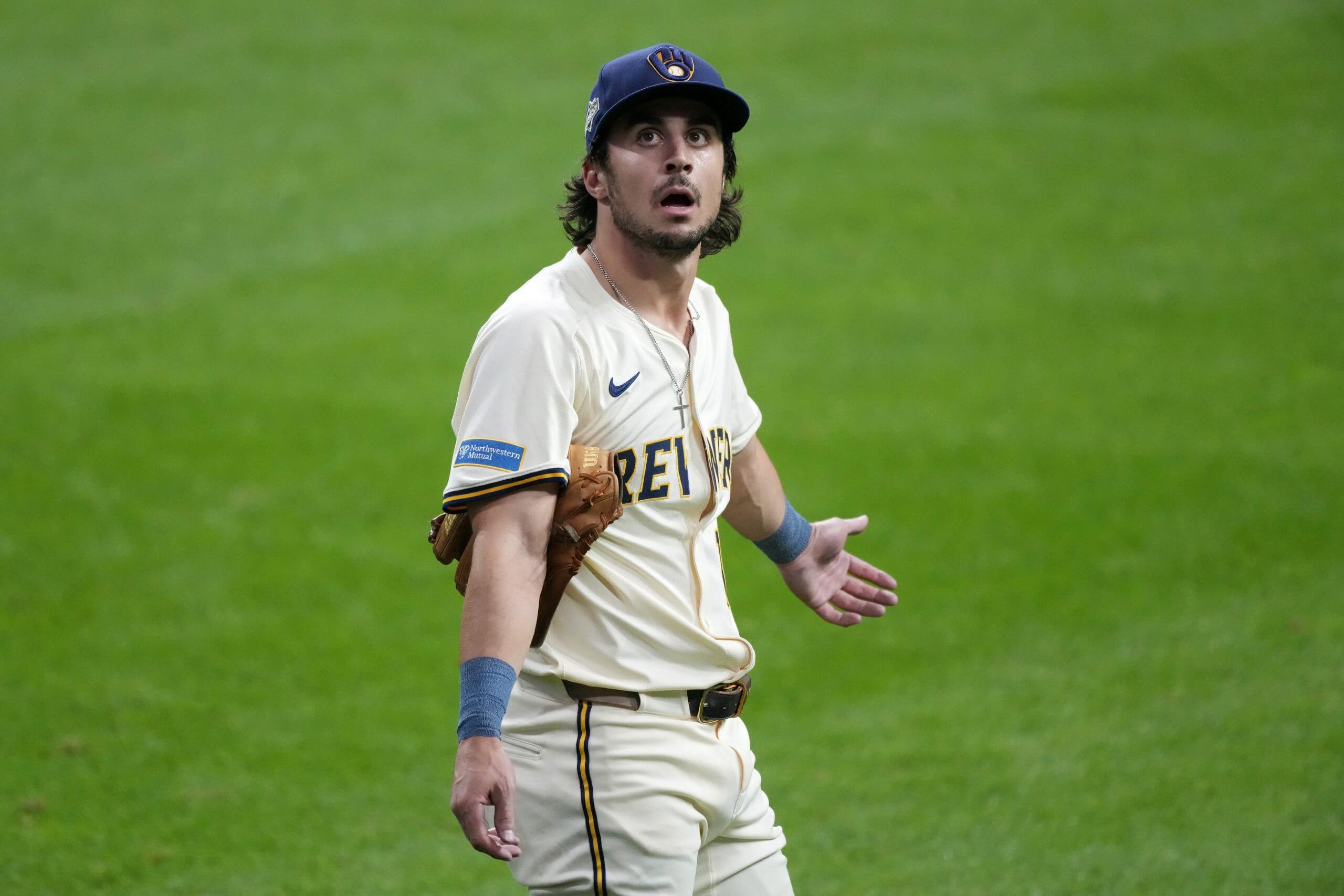
Sal Frelick’s expression says it all. (John Fisher / Getty Images)
Then again, the Brewers weren’t a whole lot less confused. Not that that stopped them from turning an all-time wild double play.
“I didn’t really know what happened,” Frelick said. “I didn’t know it hit the wall (after he deflected it). So, yeah. Weird one.”
Then, even after the whole mess went to a replay review, Frelick admitted he still had no idea what the Dodgers were appealing or even what the verdict was.
“I didn’t know what they were saying,” he confessed. “Everyone started running off the field, so I ran off. … Didn’t really have a clue what was going on until an inning later, when I could see the replay.”
So even the man who made it all happen couldn’t figure out why he was loping toward the dugout or why that big zero appeared on the scoreboard. Which means there were lots of questions to dig into. Here’s the nuttiest one of all …
How was there a “ground-ball” double play that forgot the ground?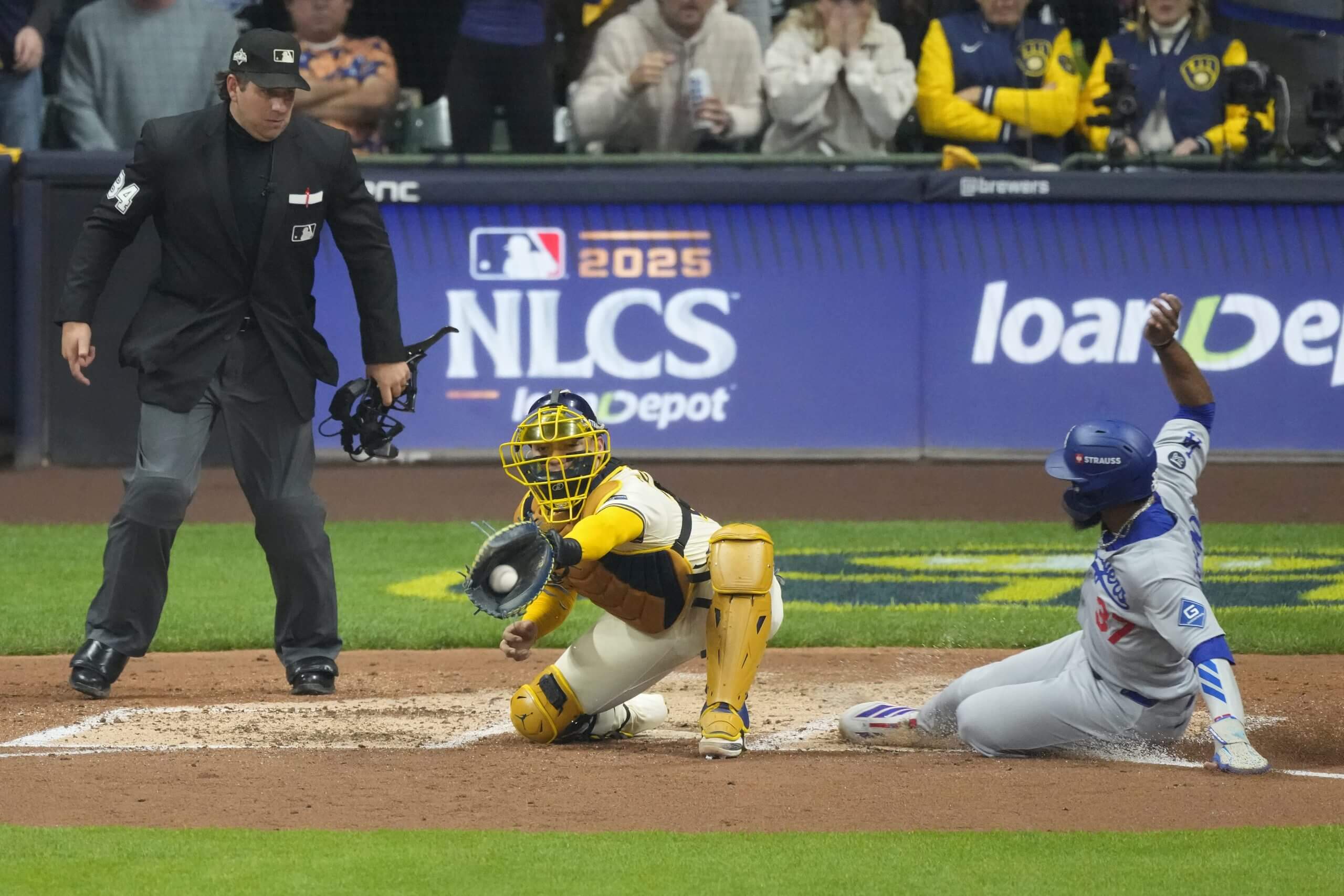
The relay throw to catcher William Contreras beats Teoscar Hernández for a forceout. (John Fisher / Getty Images)
So you thought you knew what a groundball looked like, huh? And you thought, geez, it sure didn’t look like that.
It’s hard to blame any of you for thinking that, because you might have noticed this was a baseball that never touched the ground at any point.
Not on its way to the top of the center-field fence, where Frelick got his glove on it, deflected it off the wall, then caught it again on the fly after it caromed off the fence.
Not on the incredible throw he then made to the relay man, shortstop Joey Ortiz.
Not on the perfect throw Ortiz fired to the plate, where the catcher, William Contreras, stretched for it like a first baseman and got the forceout at the plate.
And not as Contreras then looked around, realizing Smith hadn’t run for third, and trotted all the way to the third-base bag to complete this “GIDP.”
There was no “ground” in there anywhere.
Afterward, we approached the man who served up the pitch that started all this, Quinn Priester.
THE ATHLETIC: “Did you know that that went down as a ground-ball double play?”
PRIESTER (laughing): “That’s pretty spot on for me.”
TA: “Was there any ‘ground’ in it?”
PRIESTER: “No, there was a wall. There was a wall in it. But I don’t know how the heck that gets scored that way.”
Excellent question. So let’s pose it to …
The official scorer
It was the middle of a wild postseason baseball game. But how could we not ask the official scorer, Tim O’Driscoll, why he was trying to convince us all that this was a ground ball, despite the slight technicality that it never touched anything remotely similar to “the ground.”
“It’s a ground-ball double play,” he said, “because once the ball hit off the glove and off the wall, the ball wasn’t caught. … (Then) there was a forceout at home and a forceout at third. And because the ball wasn’t caught in the air, it becomes a ‘ground ball.’”
We asked if he understood the irony in that. He couldn’t help but laugh. But he had more explaining to do — saying there was no other way he was allowed, by the proper baseball authorities, to categorize it.
“When you fill in your (official scorer’s) sheet,” he said, “you can’t say yeah, it was a half-caught, deflected, grab in the air. It has to say, ‘GIDP.’”
So isn’t it amazing that he knows that, even though it doesn’t exactly happen twice a week? Just to make sure, we asked him: “Have you ever scored one like that?”
“No — and this is my 39th year,” O’Driscoll said. “I’ve scored 2,500 games. Never have I seen that before. And I got it right — which is scary.”
So have we ever seen one of these before?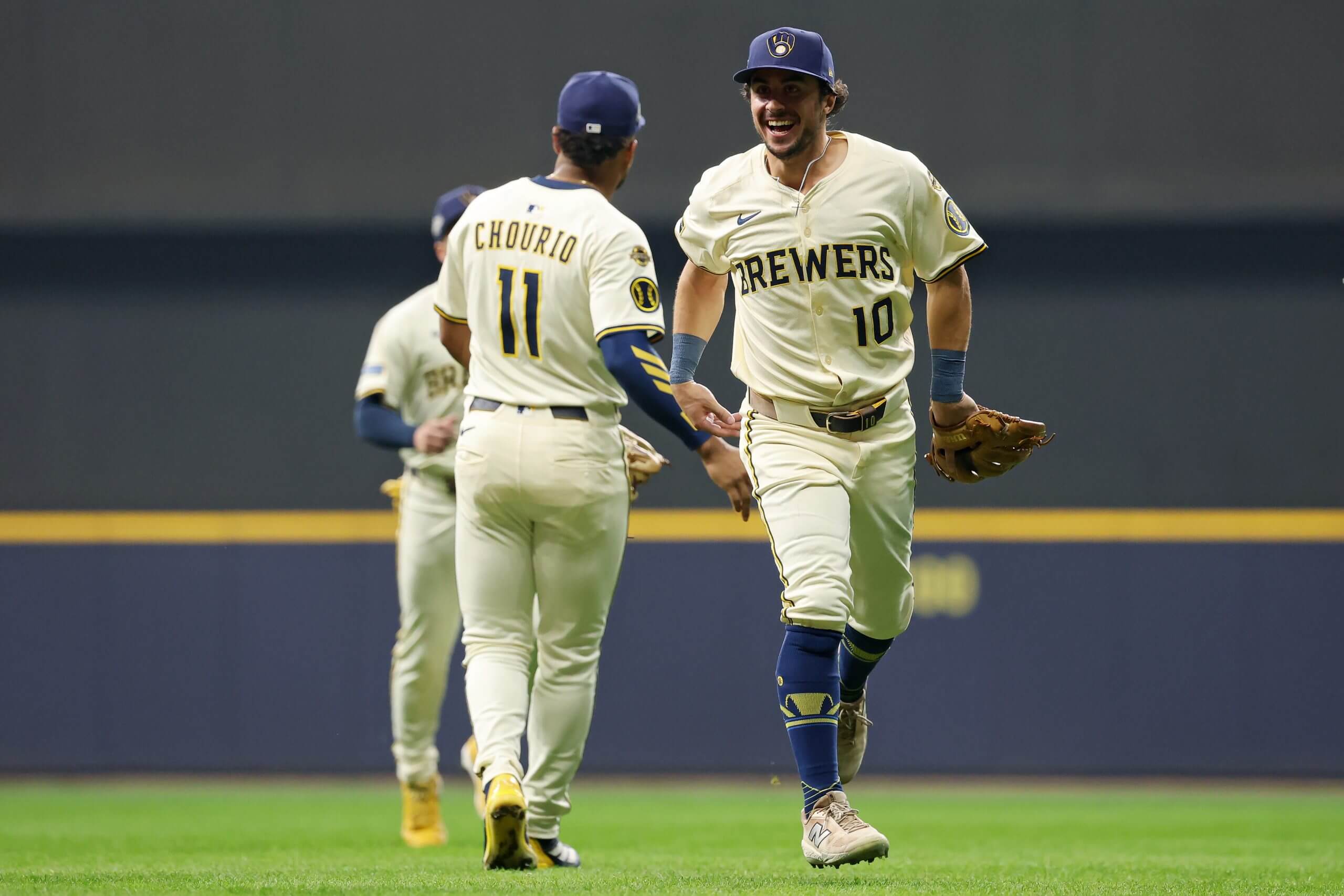
Sal Frelick and Jackson Chourio celebrate after the Brewers’ bizarre double play. (Michael Reaves / Getty Images)
In baseball, we keep track of lots and lots of stuff. So by now, you expect us knuckleheads who pay attention to that stuff to answer whatever fun question you might have about a play like this. We appreciate your confidence. But it wasn’t easy, OK?
According to STATS Perform, this was the 1,863rd game in postseason history. And this 8-6-2 special was the 2,408th double play that somebody or other had “grounded into” in postseason history. So that’s a lot of games and plays to go through, right?
Plus how could we not wonder if there had ever been a double play “like this” in the regular season? So now you’ve got a feel for the absurd degree of difficulty.
But did we aspire nonetheless to plow ahead and answer your questions? Of course we did. We were kind of curious ourselves!
First, we asked our friends from Statcast if any “grounded-into-double-play” in the Statcast era (2015-present) had ever traveled 404 feet. Even that gets a little tricky. So instead, they furnished us with this list, of the longest double plays in their annals:
1. 410 feet: Yandy Díaz, June 2, 2019
2. 404 feet: Max Muncy, 2025 NLCS Game 1
3. 403 feet: Wilson Ramos, Aug. 17, 2021
4-T. 402 feet: Anthony Rendon, June 28, 2019
4-T. 402 feet: J.J. Hardy, June 28, 2016
So Muncy ranked at “only” No. 2. But that’s misleading, since none of the other DPs were “ground-ball” double plays. According to baseball researcher Jessica Brand, the longest previous GIDP recorded by Statcast was a mere 241 feet, by the Mets’ Eduardo Escobar on Sept. 4, 2022. That one went 7-5 in your scorebook, with the “forceouts” at third base and second.
But we’re honestly just tiptoeing around the big question, don’t you think?
By which we mean …
Could there ever really have been another 8-6-2 double play like this?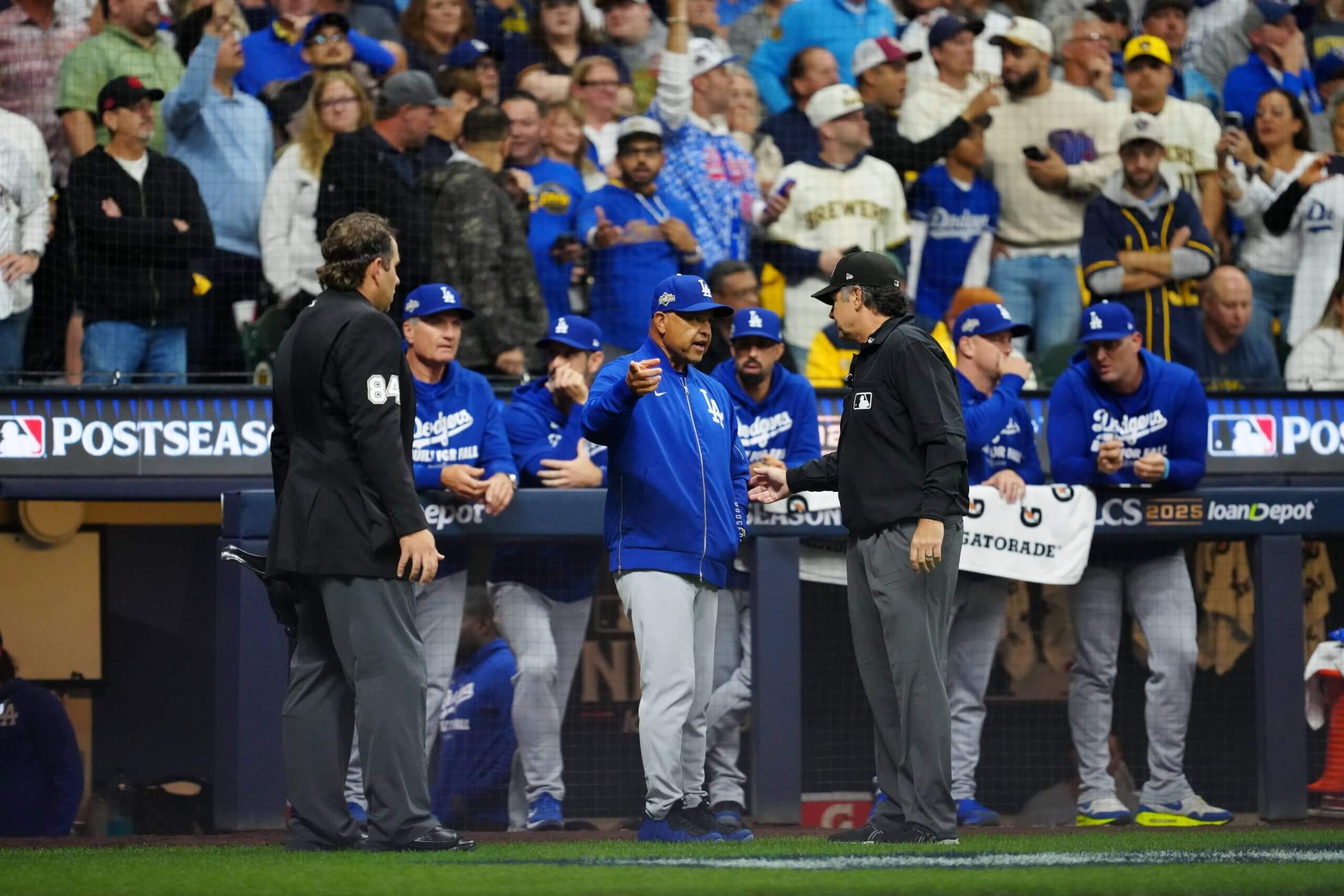
Dodgers manager Dave Roberts makes a point to the umpiring crew. After replay review, the whole thing was ruled an inning-ending double play. (Mary DeCicco / MLB Photos via Getty Images)
“You love those strange plays,” the Brewers’ Rhys Hoskins told us, perceptively, Monday night. “But have you ever seen one like that?”
Great question. The answer, of course, was: Has anybody?
We needed corroboration of that, though. So we kept searching.
Our friend Katie Sharp of Baseball Reference normally gets excited when we enlist her help in finding out stuff like this. She wasn’t quite as excited about having us interrupt a lovely dinner she was enjoying with her husband. But when she was finished, she took on the challenge, because like us, she had to know, too.
She then searched for every double play in the Baseball Reference play-by-play files in which the center fielder fielded the ball and the only two other defenders who handled it were the shortstop and the catcher. That, of course, is what happened on this play.
Just so you know, those play-by-play files are mostly complete back to 1912 for the regular season and fully complete to 1903 for the postseason. So this would essentially tell us if there had ever been another 8-6-2 double play like this in the modern era (1901-present). Want to guess what she learned?
She found just 17 other 8-6-2 double plays during the regular season and no others in the postseason. But 16 of the 17 were fly balls caught by the center fielder, so that wasn’t the same thing.
And the only other 8-6-2 DP that didn’t fit that description happened as recently as 100 years ago — on Aug. 25, 1925. But that one started with a single to center by Topper Rigney and ended with both outs at the plate. So once again, it wasn’t this.
“You come to the yard, and sometimes you see something you never saw before,” Hoskins said. “Well, you never saw that one.”
Yep. Which leads us to one final question …
Was that the strangest postseason double play ever?
That’s a tough question, friends. So we posed it to two friends who have written great, exhaustively researched books on the postseason.
One is The Athletic’s Tyler Kepner, author of “The Grandest Stage: A History of the World Series.” The other is Evan Thompson, who has written two volumes worth of books for “A Complete History of the Major League Baseball Playoffs.”
When they both nominated the same play, we knew we had another serious contender. This one happened in Game 4 of the wild and wacky 1980 National League Championship Series between the Phillies and Astros.
Want to watch it? Here it comes, complete with entertaining color commentary from Howard Cosell.
With two on and nobody out, the Phillies’ Garry Maddox thunked a soft, sinking liner toward Houston pitcher Vern Ruhle, who clearly short-hopped it and threw to first, thinking he’d just gotten one out. But that isn’t what the umpires called.
They ruled he’d caught this ball on the fly … so the Astros tagged out enough confused Phillies base runners that it was initially ruled a triple play. But that was only the first act of what became a 20-minute delay … featuring both teams arguing their cases vociferously, until this somehow became a double play … which (trust us) made no sense. It was either a line-drive out to the pitcher or a triple play. But whatever.
On Monday, I tracked down longtime Phillies shortstop Larry Bowa, who played in that game, and asked: “What do you think? Was this play even crazier than that play?”
“It was very close,” he said. “Those plays were unbelievable.”
But it turned out that the old third-base coach in Bowa’s soul was even more worked up about Teoscar Hernández’s base-running snafu Monday than he was about the bizarre DP his team hit into 45 years ago.
Asked to recall the first words out of his mouth after Monday’s play, if we could even print them, Bowa replied: “What the (heck) was the base runner thinking? That should not happen in the big leagues.”
This quick aside: If you thought the legendary Larry Bowa was mellowing after more than half a century in baseball, guess again.
But you know what else you’d think should not happen in the big leagues? A hitter sends a 404-foot rocket barreling through the sky toward the ballpark’s most distant fence … and what transpires?
It turns into a “ground-ball” double play.
But somehow, that … happened. So two hours later, the man who threw the pitch was still trying to sort out what he’d just experienced. He’d kicked off the strangest double play in postseason history. But for some reason, he was having trouble convincing himself that was a good thing.
“Crazy,” Quinn Priester said. “I guess it was cool to be a part of. But I think I would just rather have gotten a normal groundball.”
— Andy McCullough and Fabian Ardaya contributed to this report.

